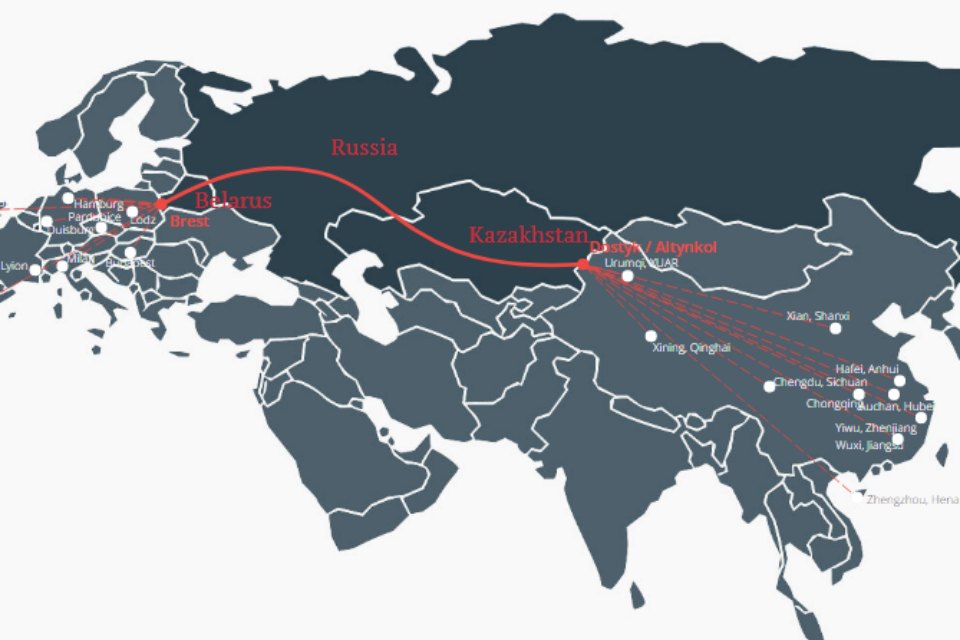Price of railway on New Silk Road closer to ‘sea level’

Tariff rates for railway transportation on the New Silk Road are now highly competitive in relation to sea transportation. The difference in tariffs between container transportation by rail and transportation by sea is less than 1000 US Dollars (875 Euros) per 40-foot container. This was concluded by the United Transport and Logistics Company – Eurasian Railway Alliance (UTLC ERA), referring to transit traffic through Russia, Belarus and Kazakhstan.
UTLC ERA is responsible for the vast majority of Eurasian railway traffic on the broad gauge railway network on the New Silk Road. According to president Alexey Grom, the company has reduced ‘the complex rate for clients by 30 per cent. “The balance of east-west and west-east container flows served as one of the main factors of cost reduction and allowed us to reduce the complex rate for the client by almost 30 per cent since 2015.
Return cargo
“The rate was 3800 US Dollars (3323 Euros) and has become 2750 US Dollars |(2405 Euros). And it will be even less, as the number of transit cargo is on the increase.” According to Grom, previously only 50 out of 100 containers shipped from Asia to Europe returned back. “At present, the percentage of return load is significantly higher. At the end of this year, UTLC ERA expects it to be 75 per cent.”
UTLC ERA expects to witness an increase of 60 per cent in transit traffic on the New Silk Road. According to the figures of 2018, the operator forecast to lift 350 thousand TEUs in 2019. It expects this year’s traffic volume to be 275 to 280 thousand TEUs, president Alexey Grom told media representatives. In 2017, the traffic volume totaled 175.8 thousand TEUs.
Optimal solution
Taking into account the additional cost savings owing to a shorter delivery time, the railway can be an optimal solution for even greater number of customers, Grom pointed out, adding that significant changes have taken place in the range of the goods transported by the company.
“In 2018, cargo owners began shipping less valuable goods regularly, such as cellulose, along transit routes. This trend indicates that when choosing a mode of transportation, the advantage of delivery speed becomes fundamental.”
Large market
“The market is so large that there is enough space for everyone”, he added. “Annually, only between South-East Asia and Europe, up to 23 million TEUs are transported, mainly by sea. If the total rail transit volume reaches 500 thousand TEUs by the end of this year, while by joint efforts in future years we bring the transit rate between Europe and China to one million TEUs, it will still be less than 5 per cent of the maritime transport volumes.”
To ensure traffic volume growth, the company has considered the possibility of increasing its fitting platforms fleet. Currently UTLC ERA possesses about 4100 platforms. As Alexey Grom said, the strategy of the company does not exclude the formation of assets and the creation of its own fleet of wagons. According to him, the company considers both a purchasing alternative and a possibility of renting or leasing.
5000 platforms
“To ensure the planned traffic volumes for the next year, we will need about a thousand more platforms”, said the company president. Therefore, we plan to complete the year of 2019 with 5000 platforms and we will strive to ensure that we have both the volumes and a fully involved fleet of platforms.”
UTLC ERA comprises of Belarusian Railways, Russian Railways and Kazakhstan Temir Zholy. Together the companies are responsible for most of the railway traffic passing through the respective countries, on transit between Europe and Asia.





